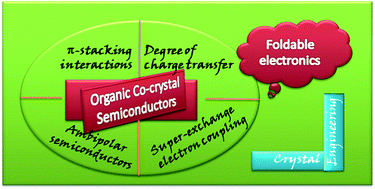Organic semiconductors are being perceived as promising materials, which will complement or even substitute inorganic semiconductors, for the development of futuristic versatile flexible electronics. The discovery of organic metal TTF-TCNQ in the early 1970s directed the attention towards organic conductors and led to the determination of the first ambipolar co-crystal semiconductor, DBTTF-TCNQ, in 2004. Although a successful commercial organic semiconductor is yet to be reported, the area is being pursued with vigor and significant advancement in the development of co-crystal semiconductors has been realized. This highlight review provides a quick guide to understand the fundamentals and developments in the area. The nature of π–π interactions and degree of charge transfer (DCT) are discussed to benefit basic learners. An account of the computational methods utilized to understand and predict the semiconductor properties of organic co-crystals is provided and a comparison of the energy splitting method (ESM) and Larsson partition method (LPM) to evaluate the super-exchange electron coupling mechanisms in the organic co-crystals is provided. Selective literature on devices or ambipolar donor–acceptor (DA) co-crystal semiconductors is provided with a special focus on donor categories: thiafulvene-TTF, diphenyl tetrathia[22]annulene-DPTTA, polyaromatic hydrocarbon-PAH, benzothienobenzothiophene-BTBT, and their derivatives. A perspective of crystal engineering intervention, and the challenges and opportunities in the development and improvisation of device properties in co-crystal semiconductors are discussed towards the end of the article.

